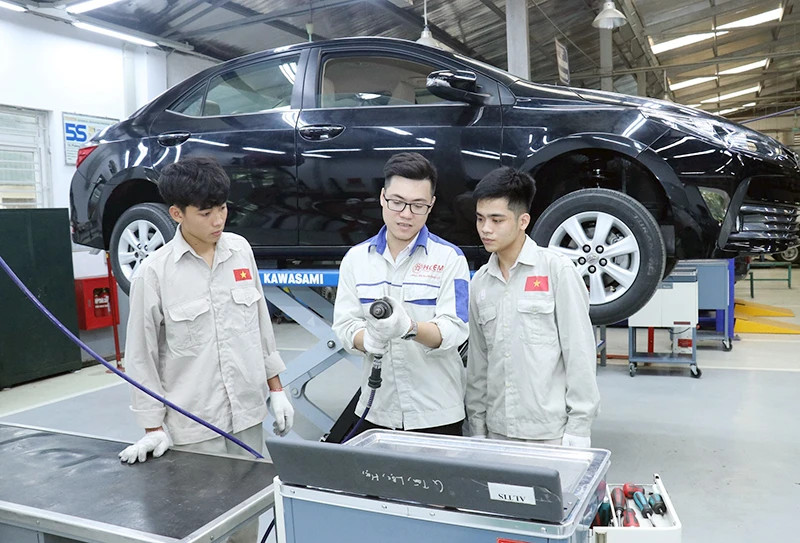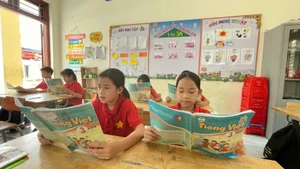In 2024, the estimated enrollment was 2,430,000 people, reaching 100% of the plan, of which 530,000 are college and intermediate level, 1,900,000 are elementary level and other vocational training programmes.
The estimated number of graduates in 2024 was 2,146,000 people, reaching 100% of the plan. Improving the quality of vocational education, linking training with the labour market, sustainable employment, and social security has been carried out synchronously in recent years.
Continuing to innovate and develop vocational education
In 2024, continuing to implement Directive No.21-CT/TW dated May 4, 2023 of the Secretariat on continuing to innovate, develop and improve the quality of vocational education until 2030, with a vision to 2045; vocational education development strategy for the 2021-2030 period, with a vision to 2045; vocational education network planning for the 2021-2030 period, with a vision to 2045, the General Department of Vocational Education under the Ministry of Labour, Invalids and Social Affairs has coordinated with localities and directed vocational education institutions to promote communication about vocational education in 2024, in which priority is given to strengthening enrollment, especially enrollment at college and intermediate levels; training high-quality programs, emerging industries, fields, new skills (artificial intelligence, semiconductor chips, energy conversion, carbon credits, hydrogen energy, logistics, high-speed rail, tourism), strengthening connections, cooperation with businesses in organising training, evaluating learners and solving employment after training, especially for new industries, new skills.
The General Department of Vocational Education and units have also strengthened vocational training activities for workers in small and medium enterprises; promptly grasp the difficulties and problems of ministries, branches, localities, vocational training institutions in vocational education activities to coordinate to resolve; deploy review, arrangement, reorganisation of public vocational training institutions to ensure reasonable distribution of industry, occupation structure, level structure, regional structure; standardisation, modernisation, socialisation, quality stratification, ensuring sufficient capacity to meet the demand for human resources through vocational training, especially human resources with high vocational skills for national development in each period.
The results showed that after ten years of implementing the Law on Vocational Education, a nationwide vocational education network has been formed; the quality of vocational training continues to improve.
According to statistics in the ASEAN region, Vietnam is in the top four, only behind Singapore and Indonesia. Vietnam has participated in ASEAN and world vocational skills competitions and achieved many outstanding milestones.
The rate of trained workers increased from 53.6% in 2016 to 69% in 2024, of which the rate of trained workers with degrees and certificates jumped from 21.39% to 28.1%.
This showed that the quality of human resources is constantly improving, especially human resources meeting the needs of key and spearhead industries and professions. Many fields that previously had to use foreign labour are now gradually being replaced by Vietnamese labour.
Improving the quality of human resources
However, in reality, the Vietnamese labour market still has many limitations. The quality of labor supply is still inadequate, as it has not met the labor demand of a modern, flexible, sustainable and integrated labor market.
To date, about 37.8 million workers have not received primary training or higher (the country has only 28.1% of workers who have been trained and have degrees or certificates).
The number of employed workers tends to increase, but the labour market is not yet developing sustainably when the number of workers with informal jobs accounts for a large proportion (in the first 9 months of 2024, the rate of workers with informal jobs was 64.6%, down 0.3 percentage points compared to the same period last year).
To complete the targets set out in the Socio-Economic Development Strategy for the 2021-2030 period, including: by 2030, the rate of trained workers with degrees and certificates will reach 35-40%; the unemployment rate in urban areas will be below 4%; the proportion of agricultural workers in the total social workforce will be below 20%; the multidimensional poverty rate will maintain an average decrease of over 1%/year according to the new poverty standard, it is necessary to synchronously implement solutions to develop a flexible, modern, effective, sustainable and integrated labor market, focusing on ensuring sustainable employment and livelihoods.
In particular, it is necessary to build and perfect the labor market information system, labor-employment database; effectively connect and regulate labor supply and demand, encourage job creation in both the public and private sectors, encourage workers to seek jobs and change jobs that match their abilities and strengths; promote sustainable job creation, effective use of labour through programs, projects, credit policies to support job creation, support workers to participate in the labour market; improve capacity and promote the work of forecasting labor demand, vocational training needs of enterprises in terms of quantity, quality, industry structure, qualifications of workers in enterprises.
















